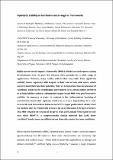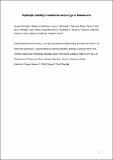Files in this item
Hydrolytic stability in hemilabile metal–organic frameworks
Item metadata
| dc.contributor.author | McHugh, Lauren N. | |
| dc.contributor.author | McPherson, Matthew J. | |
| dc.contributor.author | McCormick, Laura J. | |
| dc.contributor.author | Morris, Samuel A. | |
| dc.contributor.author | Wheatley, Paul S. | |
| dc.contributor.author | Teat, Simon J. | |
| dc.contributor.author | McKay, David | |
| dc.contributor.author | Dawson, Daniel M. | |
| dc.contributor.author | Sansome, Charlotte E. F. | |
| dc.contributor.author | Ashbrook, Sharon E. | |
| dc.contributor.author | Stone, Corinne A. | |
| dc.contributor.author | Smith, Martin W. | |
| dc.contributor.author | Morris, Russell E. | |
| dc.date.accessioned | 2019-02-13T00:34:09Z | |
| dc.date.available | 2019-02-13T00:34:09Z | |
| dc.date.issued | 2018-11 | |
| dc.identifier | 253395163 | |
| dc.identifier | ab470a9c-dc03-459b-82e6-075ed28806d0 | |
| dc.identifier | 85052336043 | |
| dc.identifier | 000447828700007 | |
| dc.identifier.citation | McHugh , L N , McPherson , M J , McCormick , L J , Morris , S A , Wheatley , P S , Teat , S J , McKay , D , Dawson , D M , Sansome , C E F , Ashbrook , S E , Stone , C A , Smith , M W & Morris , R E 2018 , ' Hydrolytic stability in hemilabile metal–organic frameworks ' , Nature Chemistry , vol. 10 , no. 11 , pp. 1096–1102 . https://doi.org/10.1038/s41557-018-0104-x | en |
| dc.identifier.issn | 1755-4330 | |
| dc.identifier.other | ORCID: /0000-0003-0362-7848/work/47531862 | |
| dc.identifier.other | ORCID: /0000-0002-4538-6782/work/56638942 | |
| dc.identifier.other | ORCID: /0000-0002-8110-4535/work/59464832 | |
| dc.identifier.other | ORCID: /0000-0001-7809-0315/work/61622104 | |
| dc.identifier.uri | https://hdl.handle.net/10023/17048 | |
| dc.description | R.E.M. thanks the Royal Society and the EPSRC (Grants EP/L014475/1, EP/K025112/1) for funding work in this area and the Czech Science Foundation for the project P106/12/G015 and OP VVV “Excellent Research Teams”, project No. CZ.02.1.01/0.0/0.0/15_003/0000417 – CUCAM. SEA thanks the Royal Society/Wolfson Foundation for a merit award, and the European Research Council (EU FP7 Consolidator Grant 614290 “EXONMR”) for funding. This research used resources of the Advanced Light Source, which is a US DOE Office of Science User Facility under contract no. DE-AC02-05CH11231 and the development of the gas cell used in this research was funded through US DOE award # DE-SC0001015. We also thank Diamond Light Source and Chiu Tang for access to beamline I11. We thank Mr Simon Vornholt for help with the electron microscopy and the EPSRC Capital for Great Technologies funding (EP/L017008/1). | en |
| dc.description.abstract | Highly porous metal–organic frameworks (MOFs), which have undergone exciting developments over the past few decades, show promise for a wide range of applications. However, many studies indicate that they suffer from significant stability issues, especially with respect to their interactions with water, which severely limits their practical potential. Here we demonstrate how the presence of ‘sacrificial’ bonds in the coordination environment of its metal centres (referred to as hemilability) endows a dehydrated copper-based MOF with good hydrolytic stability. On exposure to water, in contrast to the indiscriminate breaking of coordination bonds that typically results in structure degradation, it is non-structural weak interactions between the MOF’s copper paddlewheel clusters that are broken and the framework recovers its as-synthesized, hydrated structure. This MOF retained its structural integrity even after contact with water for one year, whereas HKUST-1, a compositionally similar material that lacks these sacrificial bonds, loses its crystallinity in less than a day under the same conditions. | |
| dc.format.extent | 7 | |
| dc.format.extent | 943313 | |
| dc.format.extent | 2343812 | |
| dc.language.iso | eng | |
| dc.relation.ispartof | Nature Chemistry | en |
| dc.subject | QD Chemistry | en |
| dc.subject | DAS | en |
| dc.subject | BDC | en |
| dc.subject | R2C | en |
| dc.subject.lcc | QD | en |
| dc.title | Hydrolytic stability in hemilabile metal–organic frameworks | en |
| dc.type | Journal article | en |
| dc.contributor.sponsor | EPSRC | en |
| dc.contributor.sponsor | EPSRC | en |
| dc.contributor.sponsor | The Royal Society | en |
| dc.contributor.sponsor | European Research Council | en |
| dc.contributor.sponsor | EPSRC | en |
| dc.contributor.institution | University of St Andrews. School of Chemistry | en |
| dc.contributor.institution | University of St Andrews. EaSTCHEM | en |
| dc.identifier.doi | https://doi.org/10.1038/s41557-018-0104-x | |
| dc.description.status | Peer reviewed | en |
| dc.date.embargoedUntil | 2019-02-13 | |
| dc.identifier.grantnumber | EP/L014475/1 | en |
| dc.identifier.grantnumber | EP/K025112/1 | en |
| dc.identifier.grantnumber | WM150021 | en |
| dc.identifier.grantnumber | 614290 - EXONMR | en |
| dc.identifier.grantnumber | ep/l017008/1 | en |
This item appears in the following Collection(s)
Items in the St Andrews Research Repository are protected by copyright, with all rights reserved, unless otherwise indicated.


